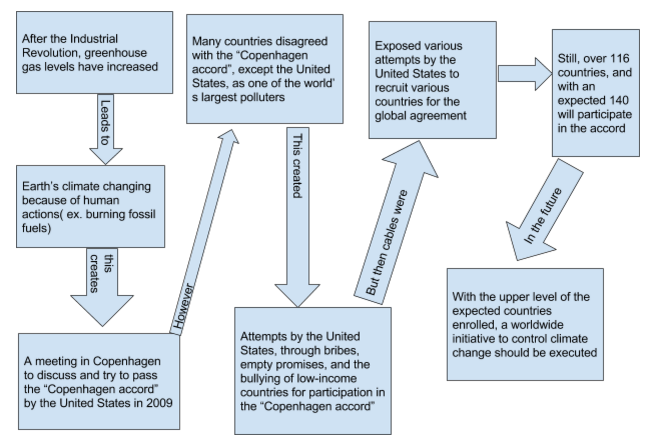1)
- My systems diagram includes the flow of ideas behind the Wikileaks article and climate change. The United Nations Convention of Climate Change in Copenhagen was formed as a response to the rising issue of climate change throughout the world. As a result, various countries, large and small, attempted to come to an agreement over a way to reduce the harm of humanity’s progress on the planet. After a few failed attempts, the United States found themselves with the “Copenhagen accord”, which favored many of the ideas and feelings that as one of the largest polluters in the world, the country favored. The accord would allow countries to set their own goals for the cutting of greenhouse gases, without determining what levels were actually beneficial. However, various countries were hesitant to sign the deal, which resulted in the United States’ interactions. Through bribes, such as a payment of $30bn to Maldives, sheer bullying based off the United States’ power, and promises of payments, almost 140 countries have signed on for the accord itself. These accounts and records were exposed finally around February 2010. But, still, countries like Japan, though not supporting the Kyoto climate treatment anymore, are supporting the accord. One can hope that through the United States’ playground like tactics that the greenhouse gas levels will begin to decline as more countries begin to execute their plans. Although there is no set plan to how much or what levels each country should decrease their emissions, a start is still a start for a larger issue.
- My view on the issue at hand looks at the situation more holistically. As a collective action towards mitigation as seen in Module 9, there are many different countries, oil based, small, and wealthy, that see emissions and climate change in different ways. However, the long term goal is to reduce climate change from an unsustainable source of fuel, fossil fuels, and into a form that will not pollute the planet. I think that the State Department cables do not play a large role in the public knowledge, whether we know or not. I simply care about the progress of the world as a whole. As a result, I have to agree with the United States’ diplomacy during the meeting in Copenhagen. If a country does not wish to participate in a goal or movement, that is their right. However, on the basis of the planet, the countries that are able to participate should help those that are hesitate, such as Maldives who cared for some money, being a small island nation. On the other side, I would have liked to see a more regulated set of boundaries for emissions set up. Being realistic though, I understand the difficulty in organizing a movement that includes 140 countries. As a result, I believe that ethically the ends justify the means, and the United States’ behavior was appropriate. While changing climate could be one of the world’s most pressing issue, I believe that some action is much better than no action at all. In addition, possibly through new acts, such as making large cities more energy efficient and communities less fossil fuel dependent with more walking roads, other countries will begin to follow. I think that having multiple countries on board for one cause, even with flaws, is much better than no countries on a well formed plan.


Hi Dhruv, my name’s Lexie and you can check out my post here: http://geog030.dutton.psu.edu/2016/04/05/lexie-gersbacher-mod-9/
I like how you started your visual with essentially where it all started “After the industrial revolution”. I also mentioned the collective action towards mitigation, as we read in Module 9, in my post as well. I don’t think that the US should’ve used threats and bribery to get countries to join, as you stated above, if a country does not wish to participate in a goal or movement, that is their right.
Hi Dhruv! Comparing our diagrams, they’re pretty similar in what we included, but what is different is that you considered and included what should happen in the future. That’s a good point to mention as this problem is still being discussed and has not been solved yet. I also agree with your holistic view of the current issue at hand. The progress of reducing climate change is the main goal and that is what should be most important in this situation. Although nations vary, the main goal is that climate change is reduced.
If you have the chance, check out my blog post: http://geog030.dutton.psu.edu/2016/04/05/climate-change-laura-young/